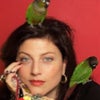A few years ago I said to a late friend, "Why do people pay ridiculous amounts of money to go pick apples?" He replied, "Because it's real." "VISITORS" is as real as the feelings we have when we watch human beings build their lives around the digital universe instead of picking apples and laughing in a green meadow. The newest human beings are relentlessly engaged in cybernetic reality, communicating in a pandemic of virtual malaria with their fingers constantly twittering bug-like on a screen, while someone shouts "Can you put that down please and engage with flesh and blood humans?!" Where we have gained in technology we have lost in human contact.
Nine years in the making, with the help of some very special "angels" who came through with a substantial amount of money to make a film about our current reality, Godfrey Reggio previewed his great work at the Museum of Moving Image in New York recently; to be released on January 24th at the Sunshine Cinema with a rollout to follow nationally and abroad. Indeed they are "angels," as the budget for "VISITORS" was a whopping 4.6 million dollars, unusual for an art film.
The film opens with Triska, a stunning lowland gorilla that silently comes through the darkness like a distant train appearing faintly through a tunnel, then suddenly, bold and brilliantly realized, she is present, as she has always been, as the observer of all that has happened since humans incarnated, watching with her maternal primordial eyes our present technologically inhabited/inhibited lives. Slowly the door flings open for a rolling river of images... We face a moonscape, an abandoned amusement park, a primeval swamp, a building with the word "VISITORS" displayed ominously on it like 50s sci-fi movie... Into the mix come our youth with a smattering of older folks, their faces contorting ever so very slowly.
Unbeknownst to me, prior to the screening of Reggio's film, all of them were engaged in some kind of visual relationship with video games, football, The Wizard of Oz movie, etc. They were not looking at the camera. The camera, however, was watching them (through complicated mirror setups) "experiencing" a reality, which in turn became another reality for the audience observing them, making the case that "we have become part cyborg," as Godfrey so fascinatingly reasons. Substantively entrancing throughout is Phillip Glass's lullaby to humanity. The original score was recorded with the superb Linz orchestra in Austria. The result is a marriage of hypnotic genius melody with the velvety black and white richness of images pushed to maximum resolution that seems solid and touchable. Godfrey Reggio and Phillip Glass have been friends since their first collaboration. Mr. Glass jokes that "working with Godfrey, really, is listening to Godfrey."
Let me declare that this is an art film of the first caliber and if you have appreciated Reggio's "Qatsi" trilogy of heady, intellectual, super-fast, trippy visually-altered imagery (about 1,500 images between all 3 films), then be prepared for his quiet, slow, emotionally poignant "VISITORS." Without words he conveys the heaviness and vastness of our planet in an exacting 75 haunting images; our lives in this current chapter of evolution while we "visit" here. Through this fluid experience it seems that we might fall off the earth if we are not careful to see the edge.
The film was shot over 46 days and edited by producer Jon Kane with a team of editors joining him over an 18-month period. He put his lucrative commercial career on hold to work with Mr. Reggio at his Red Hook studio. Mr. Kane helped translate the filmmaker's very complicated high-tech thoughts into realized pictorial moving images since, ironically, Mr. Reggio's only engagement with gadgets is a basic cell phone. I'm guessing he has a manual typewriter at home.
Mr. Kane tells me, "Some single shots took months to achieve -- for example, the three Gorilla shots alone took two animators six months to make look the way they do in the film, since those shots started as long lens color footage shot at the Bronx Zoo, from a great distance away from the animals, through thick glass and in daylight, and we needed to make it seem as though the gorilla was beautifully lit, close to the camera, in a studio, along with our people portraits."
They successfully made it all very immediate with impeccable use of technology.
That being said, it is a bit long, 15 minutes too long (hard to cut into one's own arm) and slightly confusing when Triska makes one too many appearances, though unexpected. I thought it was the end of the film, but she was to have one more turn at the podium and appear again which somehow made her seem bit less than she is meant to be. By all means see "VISITORS," because seeing it on less than the big screen and hearing it without digital surround sound might diminish its distinctive poetic voice.

